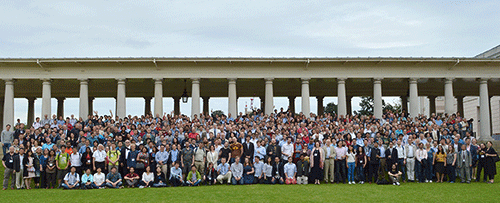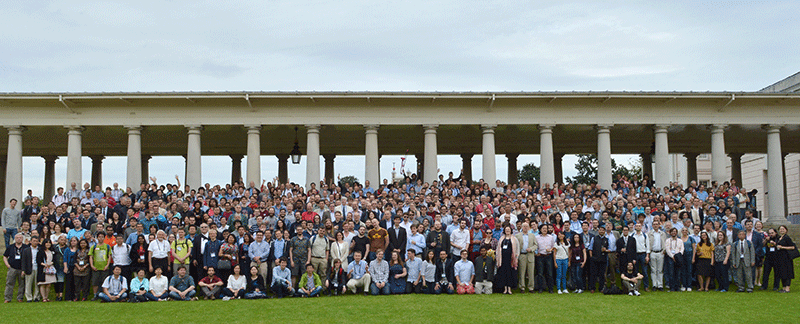Meetings: Neutrino Woodstock
Neutrinos are enjoying the limelight these days. Fresh off the heels of last year’s Nobel Prize in physics, a number of long-awaited neutrino experiments have recently come online. All of this neutrino buzz brought together 700 physicists and astrophysicists to attend the Neutrino 2016 meeting in London. Held in the Royal Geographical Society building, this biennial conference on neutrinos stood out as having a larger attendance than all its predecessors. During the opening session, Stephen Parke from Fermilab deemed it “Neutrino Woodstock.”
Top billing for the event went to the 2015 Nobel Prize winners: Takaaki Kajita, from the University of Tokyo, and Arthur McDonald, from Queen’s University in Canada, whose work in the 1990s confirmed that neutrinos oscillate between three flavors (electron, muon, and tau) and therefore must have mass. This discovery was in some sense just the beginning, said conference co-chair Silvia Pascoli from Durham University, UK. New experiments were needed to fully characterize how neutrinos oscillate, and building them caused a “lull” in neutrino physics over the last decade. But now these projects are delivering their first significant results. The stories that follow highlight some of the newsworthy items from Neutrino 2016. (See also this Collection of articles about neutrino physics from the Physics archive.)
–Michael Schirber
A New Angle on Mixing Data
The early neutrino studies of Kajita, McDonald, and others relied on neutrinos from the Sun and from cosmic-ray interactions in the atmosphere. Many of the newer experiments use “artificially made” neutrinos from nuclear reactors and particle accelerators. One of the most sophisticated examples is the Daya Bay experiment, which is made up of eight identical detectors arranged around a nuclear power plant in China. At the meeting, Zeyuan Yu from China’s Institute of High Energy Physics reported the latest Daya Bay results, confirming earlier evidence of relatively strong neutrino oscillations at distances of several hundred meters.
The physical explanation for neutrino oscillations is that the flavor neutrinos are superpositions of separate neutrino mass states (deemed m1, m2, and m3). This so-called mixing causes the probability of detecting a certain flavor to vary with distance, like a wave. This wave’s amplitude is characterized by three angles ( 𝜃12, 𝜃23, 𝜃13), and its frequency depends on the mass squared differences (say, m21−m22). Earlier work on solar and atmospheric neutrinos constrained the first two angles ( 𝜃12≈34∘, 𝜃23≈45∘) and the mass squared differences (roughly 10−4eV2), but the third mixing angle, 𝜃13, remained largely unknown. Many researchers assumed it would be close to zero—implying little mixing between the first and third mass states.
In 2012, the Daya Bay experiment caused a stir when it reported conclusive evidence that 𝜃13 is not zero (see 23 April 2012 Viewpoint). The latest results from Daya Bay are consistent with the previous findings: they show that 𝜃13 is around 8∘, with the highest precision of any experiment.
Hints of a Neutrino/Antineutrino Asymmetry
The value of 𝜃13 has important implications for other experiments that are looking for a potential difference between neutrinos and antineutrinos (see 10 February 2014 Viewpoint). If such a difference existed, neutrinos could oscillate more (or less) than antineutrinos, and a nonzero 𝜃13 means that this disparity will be easier to spot. Taking advantage of the relatively large 𝜃13, two accelerator-based experiments in Japan and the U.S. are finding possible hints of this neutrino/antineutrino asymmetry, which may help explain why the Universe contains far more matter than antimatter.
Outside of their electric charge, most particles are identical to their antiparticle partner: an electron, for example, has the same interaction with photons as does a positron. This equivalence is referred to as charge-parity (or CP) symmetry. In terms of neutrinos, a breaking of CP symmetry—characterized by the CP violating phase, 𝛿CP—would leave a detectable imprint on oscillation results.
One experiment hunting for CP violation is the T2K experiment in Japan, which generates a beam of muon neutrinos at the Japan Proton Accelerator Research Complex and detects them 295 kilometers away at the Super-Kamiokande detector. Recently, the T2K project switched from a neutrino beam to an antineutrino beam. Hirohisa Tanaka of the University of Toronto in Canada said that T2K has so far detected four antineutrino events, which is less than would be expected under CP symmetry. A preliminary analysis by T2K suggests that 𝛿CP is near one of its maximum values of 3𝜋∕2. A related experiment in the U.S., called NOvA, presented a similar 𝛿CP value.
Future Plans
The preliminary agreement between the T2K and NOvA results may seem promising, but Enrique Fernández Martínez, from the Autonomous University of Madrid, argued in his talk that current experiments will not be able to reach a 5𝜎 result—the gold standard of a discovery. That level of statistics will require a next-generation machine, such as the Deep Underground Neutrino Experiment (DUNE). Considered the next global flagship neutrino project, DUNE will have the world’s most intense neutrino beam (1.2 megawatts) and largest liquid-argon detector (40 kilotons). In his DUNE status report, Jon Urheim of Indiana University said the experiment, which already has 800 international collaborators, aims to be operational by 2026.





